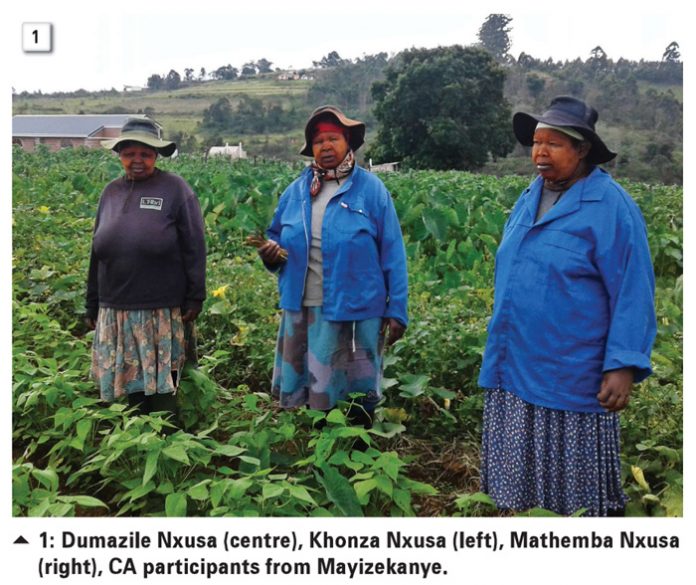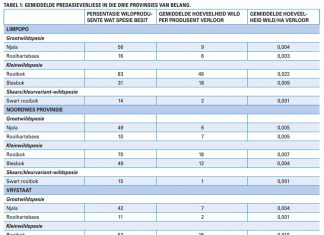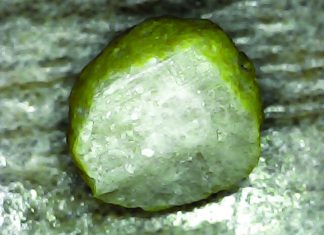September 2018
TEMAKHOLO MATHEBULA, ERNA KRUGER, Mahlathini Development Foundation and DR HENDRIK SMITH, conservation agriculture facilitator, Grain SA
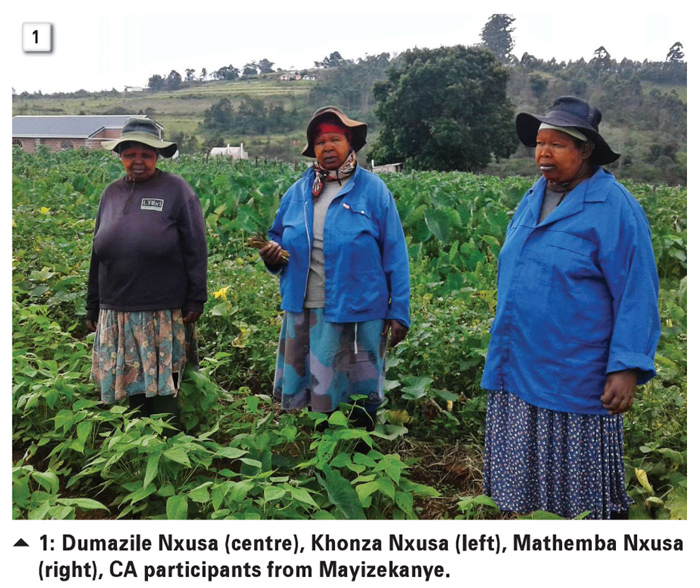 The densely populated Swayimane area situated 40 km outside Pietermaritzburg under the uMshwathi Local Municipality is well-known for vibrant subsistence farming communities. Crop production is dominant in most farming systems and the smallholder farmers mainly grow maize, beans, amadumbe, sweet potato and sugarcane.
The densely populated Swayimane area situated 40 km outside Pietermaritzburg under the uMshwathi Local Municipality is well-known for vibrant subsistence farming communities. Crop production is dominant in most farming systems and the smallholder farmers mainly grow maize, beans, amadumbe, sweet potato and sugarcane.
Animals are used for land preparation, meat and dairy, as well as during ceremonies. Maize is a staple food in Swayimane and SC 701 is the most widely used variety, which is sold as green mealies to local traders.
The Grain SA Conservation Agriculture (CA) smallholder farmer innovation programme (SFIP) is in its first season in Swayimane with the aim to promote and investigate sustainable maize production. As part of the expansion of the CA farmer innovation programme, four new learning groups have been established, one situated in Gobizembe area and three in the Mayizekanye area.
Programme implementation is farmer centred, meaning farmers are actively involved in education and training, and trials are planted by each participant at household level as part of an on-farm experimentation process central to farmer learning and adaptation.
All participants have planted first level trials which consisted of maize plus bean and maize plus cowpea intercropping treatments. Owing to the fact that many of the farmers have large fields with semi-commercial enterprises, the two-row no-till planter was used on one of the bigger fields to demonstrate the potential of CA on a commercial scale.
The main challenges identified were uneven growth and a prevalence of weeds and pests, particularly stalk borer. The varieties planted in the current season are PAN 53 and PAN 6479 for maize, Gadra beans and mixed brown cowpeas, which have proved to be well adapted to the area.
Swayimane, which forms part of the KwaZulu-Natal Midlands CA SFIP, is very promising as far as the promotion of CA is concerned, partly because it has a high potential for maize production where most of the farmers are established maize farmers who supply the local market.
Case study of Dumazile Nxusa
Mrs Dumazile Nxusa is a 66-year-old female farmer who resides in Mayizekanye with her two sisters, Khonza and Mathemba, and five children. She and her family survive primarily on farming and work as a unit, with her as the custodian.
They own eight chickens, 14 cattle and grow amadumbe, sweet potato, butternut, maize and beans in order to sell to the local community and to traders who purchase their produce and sell it in nearby Pietermaritzburg. They are also part of a family stokvel which provides a supplementary source of income.
Nxusa is no stranger to CA, as she and her group have been exposed to its principles through workshops conducted by the Department of Agriculture, Forestry and Fisheries. She started thinking more critically about implementing it after meeting with Mahlathini Development Foundation (MDF) and she and her sisters planted their trial on one of their joint fields.
The trial was divided into eight plots of 10 m x 12 m. It had two plots of maize and cowpeas and six plots of maize and beans and planting was done using hand hoes (Photo 2a and Photo 2b). The maize and beans were planted on the elevated part of the field where the subsoil is exposed possibly due to years of erosion that removed most of the topsoil.
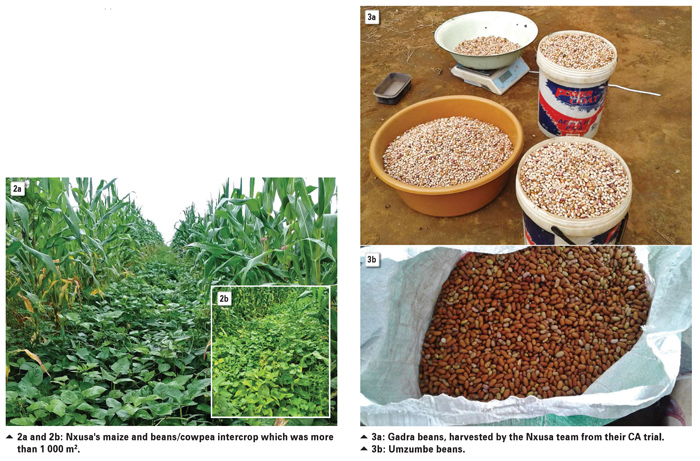
The maize and cowpea were planted on the bottom part of the field, and was greener as this seemed to be the point of accumulation of soil and nutrients in the field. The cowpeas provided a much thicker canopy compared to the beans.
The overall perfomance of the trial was good and the farmers were pleased with their bean harvest as they had expected a low yield due to recent rains which resulted in some of the beans going bad.
Problems
Moreover, they had problems with buck and rats eating their crops. The total harvest for beans was 48,17 kg equating to a yield of 1,2 t/ha (Photo 3a). The farmers also planted Umzumbe beans for the market (Photo 3b). The field is more difficult to manage as it is further away from the household, and is only one of many fields that they cultivate.
In their conventional fields or control plots, the main variety grown for the market is SC 701, which the farmers planted in their homestead and on three other fields outside the homestead.
Planting is done at different stages, starting in August. The first maize crop has been harvested and sold as green mealies and they have now planted the second crop for the season, which can be seen in Photo 4.
As a result of owning large fields, the farmers planted using the two-row no-till planter in a field of about 1 ha. The two-row planter was used for the first time in Swayimane and many lessons were learnt, such as the importance of proper seed plate settings, constant checking of fertiliser and seed pipes for blockages, working with friable soils and ensuring the bins are always full (Photo 5a and Photo 5b).
The results have been impressive in terms of the germination and growth of the maize, and the farmers were overjoyed because the planter saved a lot on fertiliser. Spacing was uneven with some patches in between, which the team will work on in order to improve it in the upcoming season.
Photo 6a and Photo 6b show maize planted using the two-row planter. Nxusa had planned to plant cover crops between the maize, but she ended up planting them in another field as the maize was already too tall.
The cover crops were planted using the haracca planter. She planted a mixture of summer and winter cover crops, which will be used as cattle fodder (Photo 7). Above the field where the cover crops were planted, she planted Gadra beans as a sole crop in order to compare the difference in yield between intercropping the beans with maize and planting them on their own (Photo 8). Photo 9a shows amadumbe, a tuber which is very popular in Swayimane. They are normally grown for household consumption. Apart from amadumbe, the farmers also grow butternut (Photo 9b) for household consumption. It was inspiring to see that all of the fields are cultivated and looked after by the family, and labourers are employed during the busiest time of the season.
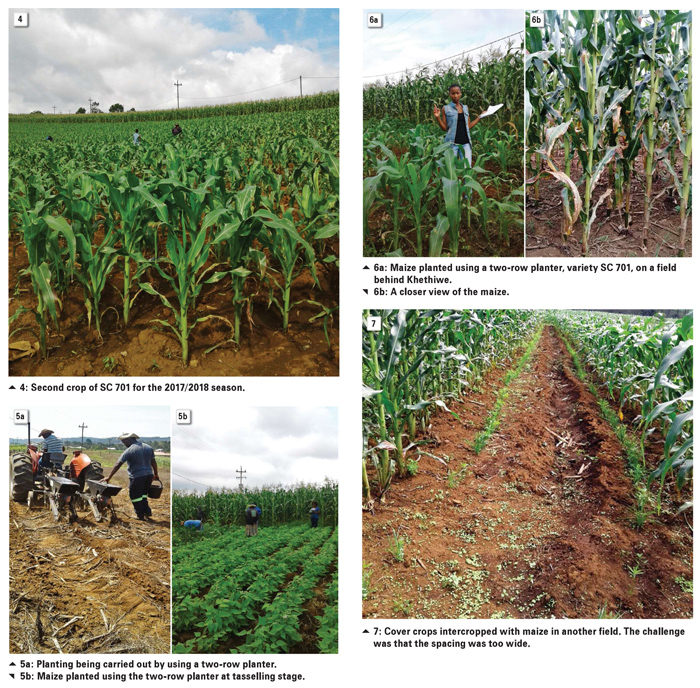

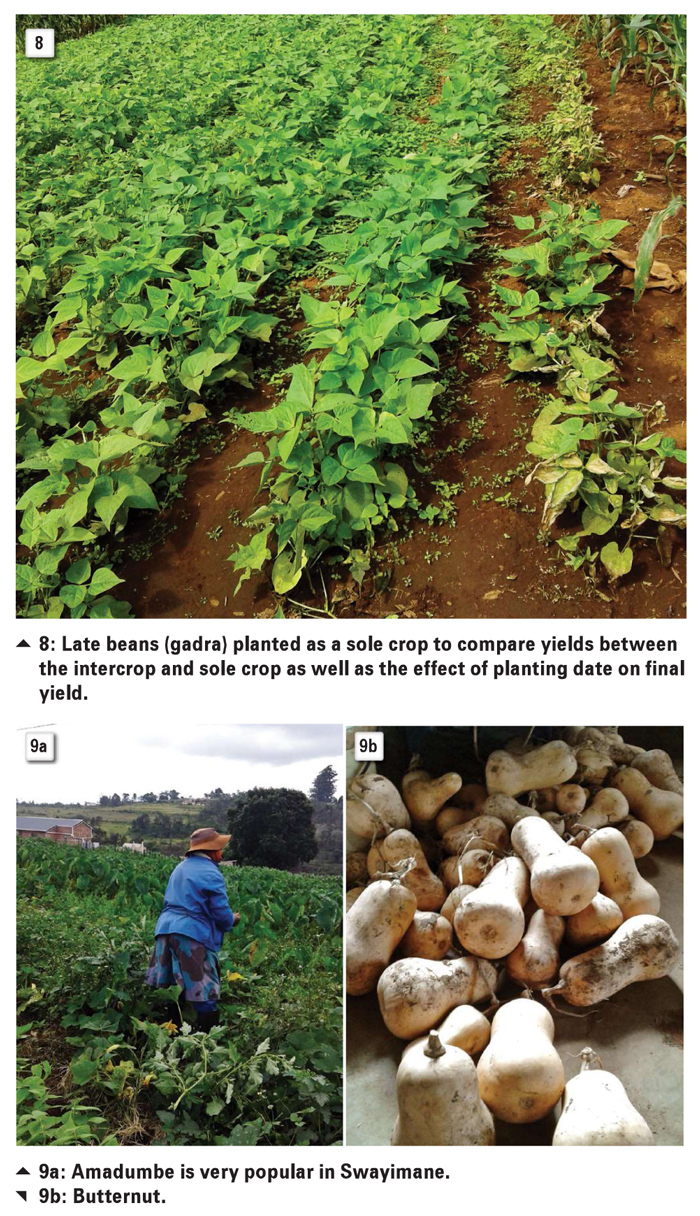 Mid-season maintenance and weeding are done manually by the three women on all the fields. What fuels their passion for farming, apart from enhanced food security, is that they have managed to make farming an economically viable enterprise and are reaping the benefits of their hard work.
Mid-season maintenance and weeding are done manually by the three women on all the fields. What fuels their passion for farming, apart from enhanced food security, is that they have managed to make farming an economically viable enterprise and are reaping the benefits of their hard work.
A highlight is that the family managed to build a new house with the proceeds from their farming activities, and even the younger generation is starting to take an interest in farming because of their resilience and hard work.
Conclusion
Farming, like any other business, involves taking risks and good returns are not always guaranteed. The current shifts in seasonal patterns and increase in erratic weather conditions have resulted in a lot of uncertainty when it comes to food production.
Conventional farming methods, especially mechanical ploughing, over the years have resulted in degraded and unstable soils with a progressive decrease in crop yields. Although the Nxusa family is doing well in terms of production, there was evidence of soil fertility issues. The maize on some fields had purple and yellow leaves, and was light green, which could mean that they have N and P deficiencies.
This case study, as part of the bigger CA programme, has shown that it is becoming essential to increase awareness and capacity in sustainable agricultural practices if long term food security is to be realised by all the smallholder categories.
CA shows great potential to address the primary issues related to soil health and crop production. Furthermore, working with an innovative group like Nxusa’s family, requires a higher level of innovation from the team to successfully incorporate CA into an already functional and successful semi commercial farming system.
At this stage it certainly seems that CA does have the potential to deliver the expected benefits.
Publication: September 2018
Section: On farm level



